Description
The missile battery market in Japan has gained significant importance in recent years as the nation focuses on enhancing its defense capabilities and strengthening its military posture in response to regional security challenges. Missile batteries play a critical role in modern warfare, providing effective defense against incoming threats and contributing to Japan’s deterrence strategy. As Japan faces evolving security threats and regional tensions, the demand for advanced missile battery systems has grown, leading to increased research, development, and investment in this field.
Missile batteries in Japan encompass a wide range of surface-to-air missile (SAM) and surface-to-surface missile (SSM) systems, which are designed to counter different types of threats. These systems are deployed on land, at sea, and in the air, providing comprehensive defense capabilities against a variety of airborne and surface threats.
One of the primary applications of missile batteries in Japan is in air defense. Japan’s geographical location and proximity to potential adversaries necessitate a robust air defense posture. Surface-to-air missile batteries, integrated with sophisticated radars and command and control systems, form a crucial part of Japan’s air defense network. These systems can detect and engage incoming aerial threats, such as hostile aircraft, cruise missiles, and ballistic missiles, protecting vital assets and population centers.
Moreover, missile batteries are also utilized for maritime defense. Japan’s maritime domain includes crucial sea lanes, territorial waters, and exclusive economic zones (EEZs), making naval defense a significant priority. Surface-to-surface missile batteries, deployed on naval vessels and coastal defense units, enhance Japan’s ability to respond to maritime threats and project power across the region.
Additionally, missile batteries are essential for land-based operations. Ground-launched surface-to-surface missile systems provide Japan with precision strike capabilities, enabling the nation to address potential threats or project force when necessary.
As Japan emphasizes indigenous defense capabilities, the domestic production and development of missile batteries have seen substantial growth. Collaborations between the government, defense industry, and research institutions have fostered innovation, leading to the creation of advanced missile battery systems tailored to Japan’s specific defense requirements.
Japan’s alliance with the United States has also played a significant role in the development of its missile battery capabilities. Through this partnership, Japan has access to advanced technologies and expertise, contributing to the modernization of its defense forces and enhancing interoperability with allied nations.
The missile battery market in Japan also benefits from advancements in missile technology, propulsion systems, and guidance systems. Manufacturers have leveraged these developments to create missile batteries with improved range, accuracy, and lethality.
However, the missile battery market in Japan also faces challenges related to cost, evolving threats, and public acceptance. Developing and maintaining advanced missile battery systems can be costly, requiring significant investment in research, development, production, and training.
Addressing evolving threats is also crucial, as adversaries may employ more sophisticated countermeasures and tactics to overcome missile defenses.
Public acceptance of missile defense capabilities can also be a consideration, as there may be concerns about safety, environmental impact, and international relations.
In conclusion, the missile battery market in Japan has witnessed significant growth and strategic importance, driven by the nation’s focus on enhancing its defense capabilities and strengthening its military posture in response to regional security challenges. Missile batteries provide critical capabilities for air defense, maritime defense, and precision strike operations, making them integral to Japan’s defense strategy. The collaboration between the government, defense industry, and research institutions, as well as international partnerships with allied nations, fosters innovation and contributes to the growth of the domestic missile battery market. Addressing challenges related to cost, evolving threats, and public acceptance is crucial for further enhancing Japan’s missile battery capabilities and ensuring the nation’s ability to effectively defend against airborne and surface threats. With its strategic focus on enhancing indigenous defense capabilities, Japan remains committed to leveraging advanced missile battery technologies to enhance its defense capabilities and contribute to regional and global security.




